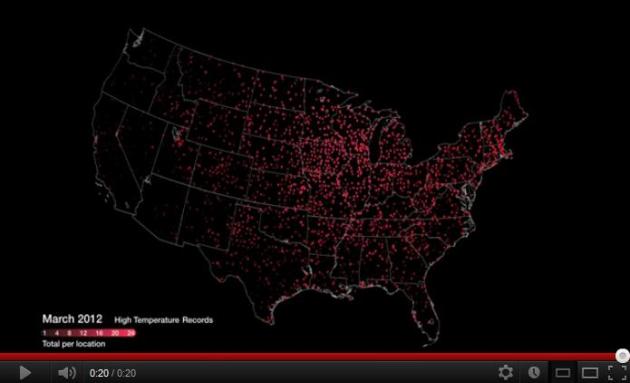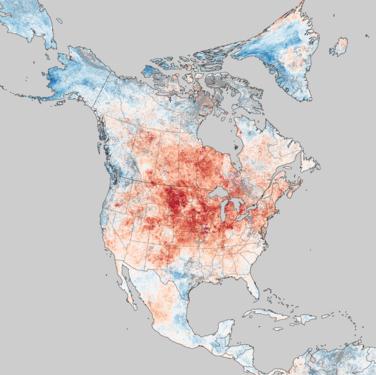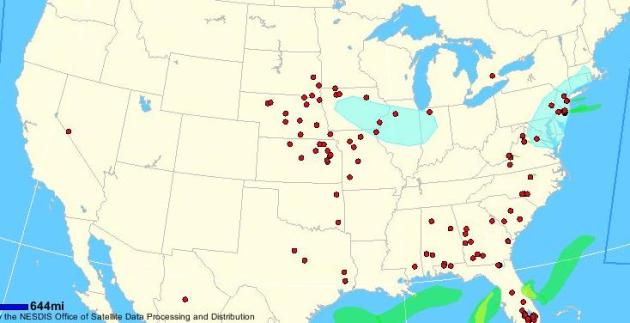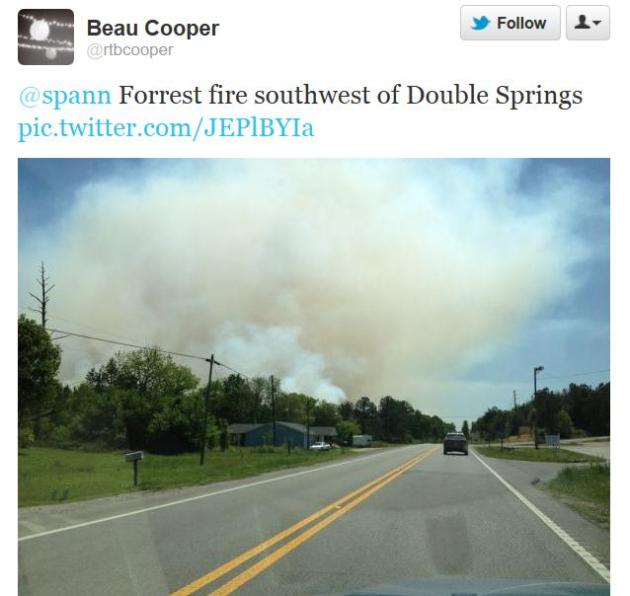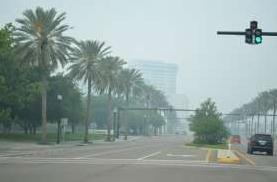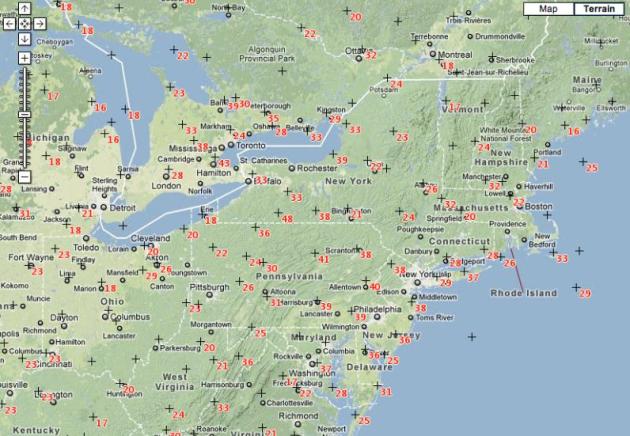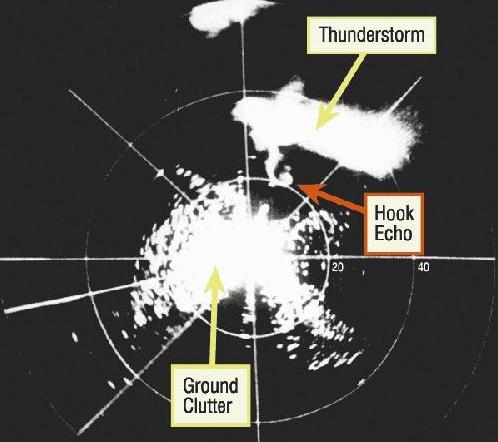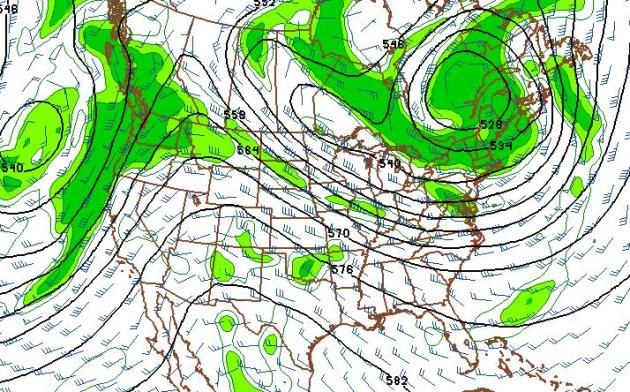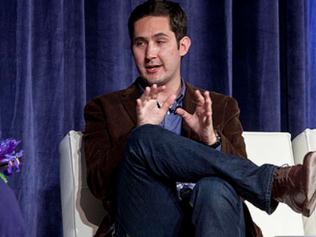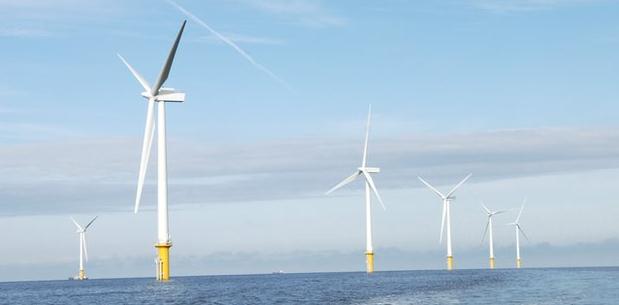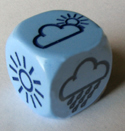 42.5 F
42.5 F. average temperature across the USA for March.
51.1 F. average March temperature in 2012; closer to the average for April.
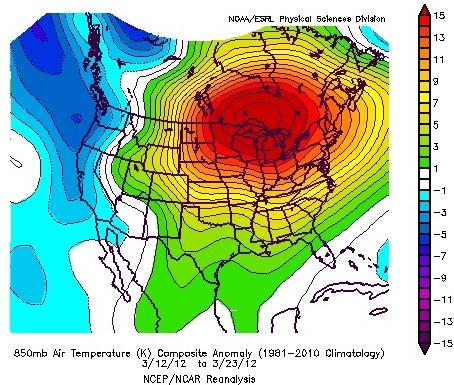 15, 292
15, 292 warm weather records in March. A record number of records. Map above: NOAA NCEP.
All 50 states broke at least one warm weather record last month.
First Quarter Of 2012: Warmest on record across the USA.
35:1. Warm weather records blew away cold weather records across the USA in March by a ratio of more than 35 to 1.
4 1/4" hail reported at Woodward, Oklahoma reported at 5:21 pm Monday - "windows broken". That's baseball size.
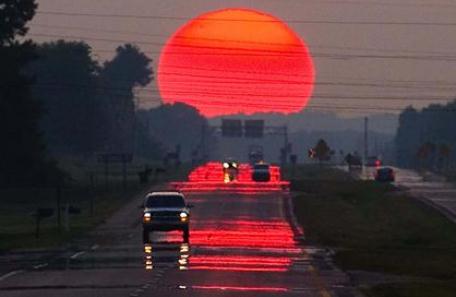
"
Even looking at the span from March 15 to March 31, 2012 was the first time that the second half of March did not have a minimum temperature below freezing." (1891-2012 records) - Pete Boulay, Minnesota Climatology Working Group. Photo: Matt McKean/AP.
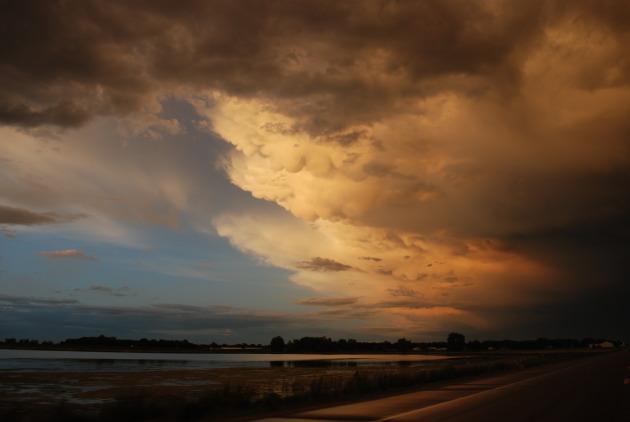
“
When you look at what’s happened in March this year, it’s beyond unbelievable,” said University of Victoria climate scientist Andrew Weaver.....
The first quarter of 2012 broke the January-March record by 1.4 degrees. Usually records are broken by just one- or two-tenths of a degree. U.S. temperature records date to 1895." - from a Washington Post article below.
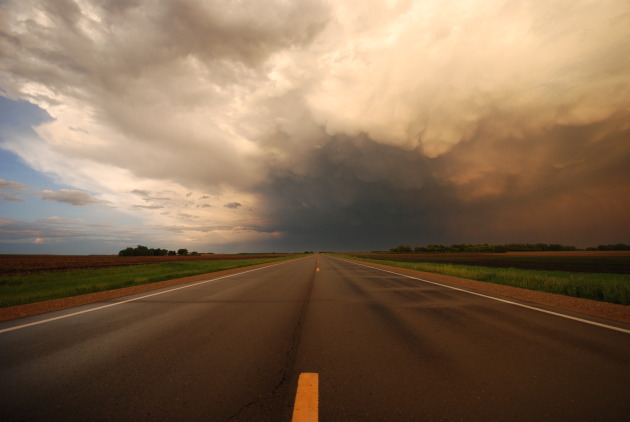
“
Everybody has this uneasy feeling. This is weird. This is not good,” said Jerry Meehl, a climate scientist who specializes in extreme weather at the National Center for Atmospheric Research in Boulder, Colo. “It’s a guilty pleasure. You’re out enjoying this nice March weather, but you know it’s not a good thing.” - from an article at goupstate.com.
U.S. Records Warmest March; More Than 15,000 Warm Temperature Records Broken. Details from
NOAA's NCDC: "
First quarter of 2012 also warmest on record; early March tornado outbreak is year's first "billion dollar disaster" Record and near-record breaking temperatures dominated the eastern two-thirds of the nation and contributed to the warmest March on record for the contiguous United States, a record that dates back to 1895. More than 15,000 warm temperature records were broken during the month. The average temperature of 51.1°F was 8.6 degrees above the 20th century average for March and 0.5°F warmer than the previous warmest March in 1910. Of the more than 1,400 months (117+ years) that have passed since the U.S. climate record began, only one month, January 2006, has seen a larger departure from its average temperature than March 2012."
 Not Just March, But Start Of 2012 Shatters U.S. Records For Heat, Worrying Meteorologists
Not Just March, But Start Of 2012 Shatters U.S. Records For Heat, Worrying Meteorologists. Here's an excerpt of an article from
The Washington Post: "
WASHINGTON — It’s been so warm in the United States this year, especially in March, that national records weren’t just broken, they were deep-fried. Temperatures in the lower 48 states were 8.6 degrees above normal for March and 6 degrees higher than average for the first three months of the year, according to calculations by the National Oceanic and Atmospheric Administration. That far exceeds the old records. The magnitude of how unusual the year has been in the U.S. has alarmed some meteorologists who have warned about global warming. One climate scientist said it’s the weather equivalent of a baseball player on steroids, with old records obliterated. “Everybody has this uneasy feeling. This is weird. This is not good,” said Jerry Meehl, a climate scientist who specializes in extreme weather at the National Center for Atmospheric Research in Boulder, Colo."
March: "A Record Number Of Records". Details (and a YouTube clip) from NOAA: "
According to NOAA scientists at the National Climatic Data Center (http://www.ncdc.noaa.gov/sotc/), record and near-record breaking temperatures dominated the eastern two-thirds of the nation and contributed to the warmest March on record for the contiguous United States, a record that dates back to 1895. This animation shows the locations of each of the 7,793 daytime and 7,493 nighttime records (or tied records) in sequence over the 31 days in March."
Weirdly Warm March Makes Many Meteorologists Sweat. The story from
goupstate.com: "
WASHINGTON—It’s been so warm in the United States this year, especially in March, that national records weren’t just broken, they were deep-fried. Temperatures in the lower 48 states were 8.6 degrees above normal for March and 6 degrees higher than average for the first three months of the year, according to calculations by the National Oceanic and Atmospheric Administration. That far exceeds the old records. The magnitude of how unusual the year has been in the U.S. has alarmed some meteorologists who have warned about global warming. One climate scientist said it’s the weather equivalent of a baseball player on steroids, with old records obliterated."
Map credit above: NASA.
NOAA "Fire Detect" Click on
this URL to get a real-time update of current brush fires and wildfires and resulting smoke plumes - courtesy of NOAA.
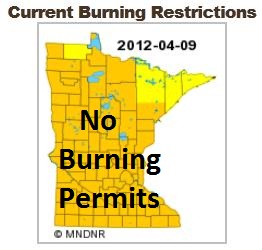 Minnesota Fire Status Report
Minnesota Fire Status Report. The Minnesota DNR has the
latest on a very dangerous fire situation statewide. Today's winds, low humidity and bright sun made a bad situation even worse: "....
The MNICS Incident Management Team A (Aultman) has been assigned to the Jeep Fire near Nimrod. Evacuations were ordered to protect citizens in the path of the fire. The fire is currently 80 percent contained and will be assessed for potential peat fire. RED FLAG WARNINGS have been issued for this afternoon and early evening for areas south of a line from Wheaton in Traverse County to Rushford in Fillmore County. All areas are staffed with a full complement of personnel and equipment, prepared for heavy initial attack. Additional hand crews and air resources have been deployed to assist with fires. Prescribed burns have been temporarily shut down until fire danger conditions lessen." Map above:
Minnesota DNR.
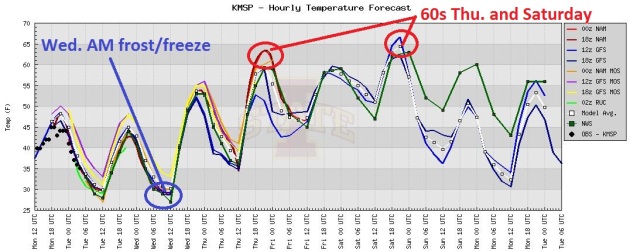 Wednesday Morning Freeze, Then 60s By Thursday Afternoon
Wednesday Morning Freeze, Then 60s By Thursday Afternoon. Talk about a temperature roller coaster:
waking up to 27 or 28 Wednesday morning with clear skies and light winds, followed by low to mid 60s just 36 hours later. The best chance of weekend 60s: Saturday.
 ECMWF: Spring Fling
ECMWF: Spring Fling. I know it's depressingly chilly out there - but the sun is too high in the sky for any chill to last for long. Highs reach the mid 50s to mid 60s from tomorrow through much of next week.
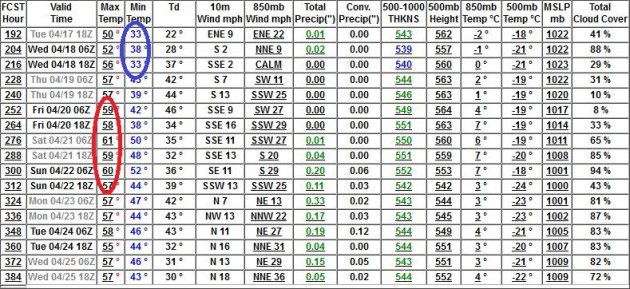 April 17-25: Slight Mellowing Trend.
April 17-25: Slight Mellowing Trend. There's a small chance of frost in the outlying suburbs a week from now, but I don't think the frost will be nearly as widespread or severe as this morning and Wednesday morning. Highs reach the 60s the weekend of April 21-22; no more vigorous cold fronts in sight through April 25.
Albert Lea Grass Fire. Thanks to Jarrod Schoenecker and
Facebook for sharing this information about a grass fire in the Albert Lea area: "
A large grass and brush fire within the southwest parts of the Albert Lea city limits. The fire appears to mostly have taken place in the Albert Lea Audubon Wildlife Nature Preserve or an adjacent grassland and marsh. The fire departments of the City of Albert Lea, Albert Lea Township, Conger, Clarks Grove, Glenville, Manchester, and Alden responded. These were taken about Noon. The fire was almost completely extinguished by the time I arrived. I had heard two rounds of sirens, which isn't uncommon at my place since the ambulances go by to the hospital and such. When I heard the third I turned on the scanner and realized that those were neighboring fire departments responding to calls for help with the fire. Even arriving late, the Albert Lea police department blocked most viewable streets to the fire. When I was able to get in these are what I got. From the best I could tell, this fire burned maybe about 40 acres and came within 200 yards of homes. Very lucky people indeed! Had the fire started on the houses in the south side of Albert Lea, I can't imagine what would have happened!"
Dixie Brush Fires. Minnesota isn't the only state grappling with a significant fire threat - Red Flag Watches and Warnings are reported from the northeastern USA southward to Florida, Alabama and Mississippi. Thanks to James Spann and Beau Cooper for passing this tweet along.
Spreading Smoke Causes Jacksonville Officials To Issue Air Quality Advisory. Details from
jacksonville.com: "
If you're anywhere along the First Coast today, you can't help but smell that nasty, dry spring smell. Firefighters are still trying to contain six of 20 wildfires burning in Northeast Florida, with other blazes likely to erupt in the coming days because of extremely dry conditions and no rainfall expected for at least a week, fire and weather officials said Monday. The biggest fire resulted from a lightning strike that has burned nearly 12,000 acres of mostly forest land at the Columbia-Baker county line. That fire, which is about 30 percent contained, caused heavy smoke to drift into the Jacksonville area today as winds shifted from when the fire first started last week, said Dave Shuler, a meteorologist with the National Weather Service."
Photo credit above: "
DAN SCANLAN/The Times-Union. Riverside Avenue’s trees disappear into the smoke at 10 a.m. Monday, looking southwest."
Blustery Monday. The greater the temperature contrast - the stronger the winds have to blow, and winds gusted over 40 mph across Pennsylvania and upstate New York yesterday.
First Recorded Hook Echo? From the WeatherNation TV
Facebook site: "
On this day in 1953, the first radar hook echo of a tornado was recorded near Champaign, IL. (photo courtesy of the Illinois State Water Survey, INRS, University of Illinois).The Illinois State Water Survey is home to the first ever documented radar hook associated with an actual tornado. Water Survey staff captured the historic event on film on April 9, 1953. This was a major turning point in monitoring severe weather, demonstrating that tornadoes could be identified by radar. This discovery helped lead to the first national weather radar network in the United States. The radar was located at Willard Airport, south of Champaign IL, and was being used along with a rain gauge network to relate radar signals with rain rates. Don Staggs, the radar technician, had stayed late to complete repairs on the radar. While testing the repairs, he noticed an interesting radar return and began recording the radar scope using the mounted 35 mm camera. As a result, he captured a well-defined hook echo (see photo) on film. Afterwords, researchers related this information to damage and photos along the tornado’s path." Source:
Illinois State Climatologist.
"Ask Paul". Weather-related Q&A.
Greetings!
"
How many tornadoes touched down in Minnesota in 2011? Nationally?"
Many thanks,
Andra Van Kempen
Communications Specialist, CetraCare Health System
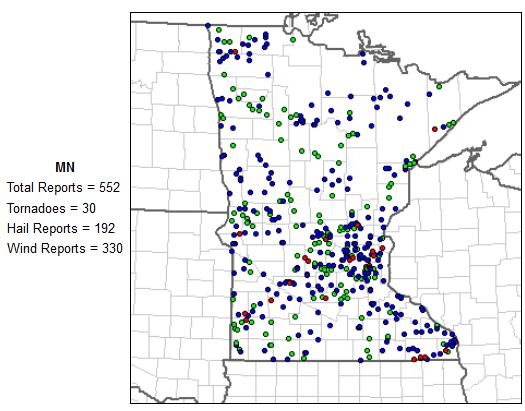
Andrea- here is the raw information from SPC, NOAA's
Storm Prediction Center. Minnesota experienced 30 tornadoes; nationwide the (preliminary count - still subject to revision) was 1,894.
__________________________________________________________________________
Paul,
"I can’t seem to recall a calm day in my recent memory. Is it just me, or has it been windy a lot lately? What is the reason for this? I’m really looking forward to a calm, easy-going hair day!"
Ian Gacek
Ian- I can sympathize with the "bad hair day" remark. I've had a couple of bad-hair-decades, but that's not relevant. The bottom line with your prescient observation: the greater the swings in temperature, the stronger winds have to blow to keep the atmosphere in equilibrium. Going from 20s to 60s results in strong winds. The only time we see light winds is under the center of high pressure, with a weak pressure gradient and near-constant temperatures. We should have those conditions tomorrow, winds generally under 10 mph. under a blue sky.
Nokia And Microsoft Take On iPhone By Going Local. I'm partial to my iPhone, but this new Nokia/MS phone does sound pretty cool - my wife won't be happy if I'm walking around with a smart phone in each pocket. But hey, she doesn't read this blog, so what the heck. Details from
mashable.com: "
Windows Phone just got a big boost from the Nokia Lumia 900, the first phone on the platform to boast an ultra-fast LTE network connection — something you can’t get with the iPhone. The Windows Phone camp also has a plan to attack Apple’s iOS platform where it’s strongest: the app catalog. The strategy, in a nutshell: Go local. Microsoft‘s Windows Phone Marketplace recently passed 80,000 apps — much more than the 7,000 or so apps it had when it first announced the deal with Nokia, which basically saw Nokia abandon its in-house platforms to become a Windows Phone manufacturer."
Want To Have An Exit Like Instagram? Here's Something Every Founder Needs To Know. Some interesting ideas in this article from
businessinsider.com; here's an excerpt: "
The Instagram team just scored a huge $1 billion exit, selling the company to Facebook. Here's one of the most important lessons that entrepreneurs can learn from CEO Kevin Systrom, to get to an exit like this: Adapt and and pivot when your inat happeitial idea doesn't work out (because chances are it won't). Before Instagram there was Burbn. Haven't heard of it? No surprise. Burbn, a mobile social check-in app with game features, quietly dropped off of Systrom's LinkedIn profile recently, but in March 2010 was making headlines for scoring $500K from Andreessen Horowitz and other investors. So what happened? Not enough, apparently."
Photo credit above: "
Kevin Systrom, Instagram CEO, Speaks at IGNITION West." Courtesy: Business Insider.
 "Cover Up Your Dandelions!"
"Cover Up Your Dandelions!" Some good advice from WeatherNation TV meteorologist Todd Nelson. That's his back yard up in St. Michael - he's ready for a freeze this morning, again Wednesday morning. Winter's last gasp? I hope so.
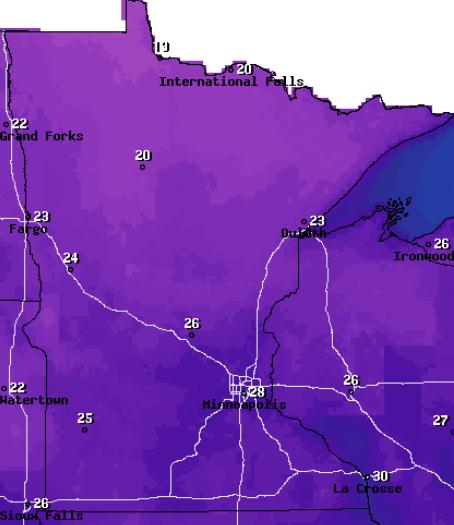
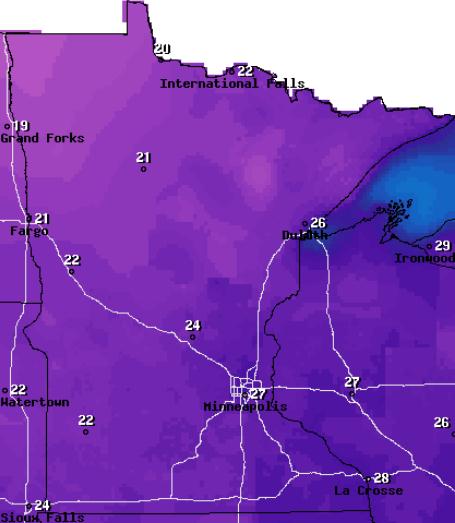 Predicted Lows This Morning Tuesday Morning Predicted Wake-up Temps
Predicted Lows This Morning Tuesday Morning Predicted Wake-up Temps.
* maps courtesy of
NOAA.
"Freeze Your Buds Off"
As you nurse your frozen flowers through a near-death experience and chisel fancy designs onto your frosted windshield this morning, keep in mind we'll probably never live through another fast-forward spring quite this remarkable. NOAA reports 15,292 warm weather records in March. From what I can tell it was a record number of records, for any month. It was also America's warmest January - March since accurate records began in the mid-1800s. 35 times more warm weather records than cold records last month. Amazing.
Plenty of snow is still on the ground over central Canada, nights long enough to brew up a few numbing airmasses, capable of leaking southward into the lower 48.
Will a "freeze" (several hours colder than 28F) kill off my flowers? I'm not a gardener, and I don't play one on TV, but my humble advice is to cover those tender plants with mulch or newspaper (Paul's weather column?) again tonight.
I'm still worried about drought, low lake water levels and a nagging fire risk; we may be sliding into a slightly wetter pattern. Showers and (strong) T-storms arrive Friday and Saturday; Sunday looks like the drier day. No more whining about rain in the forecast until further notice - our drought continues to worsen. .
Climate Stories...
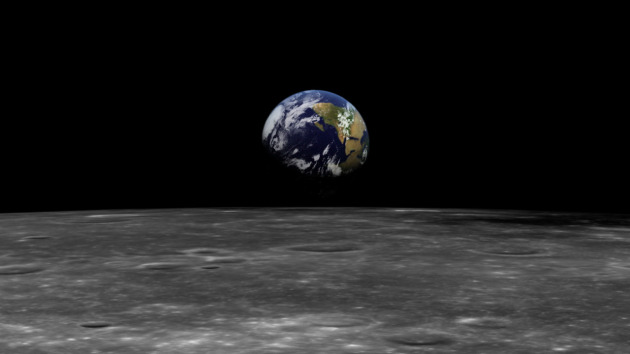 March Heat Records Crush Cold Records By Over 35 To 1; Scientists Say Global Warming "Loaded The Dice"
March Heat Records Crush Cold Records By Over 35 To 1; Scientists Say Global Warming "Loaded The Dice". Some
amazing details from Think Progress: "
The final data is in for the unprecedented March heat wave that was “unmatched in recorded history” for the U.S. (and Canada). New heat records swamped cold records by the stunning ratio of 35.3 to 1. This ratio is almost off the charts, even with the brutally warm August we had, as this chart from Capital Climate shows. For the year to date, new heat records are beating cold records by 22 to 1, which trumps the pace of the last decade by more than a factor of 10! I like the statistical aggregation across the country, since it gets us beyond the oft-repeated point that you can’t pin any one record temperature on global warming. A 2009 analysis shows that the average ratio for the 2000s was 2.04-to-1, a sharp increase from previous decades. Lead author Dr. Gerald Meehl explained, “If temperatures were not warming, the number of record daily highs and lows being set each year would be approximately even.”
A Fresh Look At How Humans Are "Loading The Dice". An YouTube clip and update from
The New York Times: "
James E. Hansen, the longtime climate scientist who has turned increasingly to activism in recent years, has updated his analysis of how the buildup of human-generated greenhouse gases is loading the climate “dice” so that hotter extremes are ever more likely. I talked with him in 2008 about his use of this apt metaphor. Here’s the video of our chat, followed by the abstract of his latest draft paper, “Public Perception of Climate Change and the New Climate Dice”."
"Public Perception Of Climate Change And The New Climate Dice". The new Hansen paper is
here, courtesy of Cornell University: "
Climate dice", describing the chance of unusually warm or cool seasons relative to climatology, have become progressively "loaded" in the past 30 years, coincident with rapid global warming. The distribution of seasonal mean temperature anomalies has shifted toward higher temperatures and the range of anomalies has increased. An important change is the emergence of a category of summertime extremely hot outliers, more than three standard deviations (3{\sigma}) warmer than climatology. This hot extreme, which covered much less than 1% of Earth's surface in the period of climatology, now typically covers about 10% of the land area. It follows that we can state, with a high degree of confidence, that extreme anomalies such as those in Texas and Oklahoma in 2011 and Moscow in 2010 were a consequence of global warming, because their likelihood in the absence of global warming was exceedingly small. We discuss practical implications of this substantial, growing, climate change."
What We Knew In 1981. The climate supercomputer simulations back in 1981 were eerily prescient - if anything warming (especially northern latitudes) has been faster than predicted more than 30 years ago). Here's an excerpt of an article from Peter Sinclair at
climatecrocks.com: "
A lot of people really appreciated getting a look at Mike MacCracken’s 1982 (above) lecture at Sandia Labs, which gave a comprehensive overview of what was then known about climate change. Quite a lot, it turns out. RealClimate has just posted a reminder of a similar compilation a year earlier, James Hansen’s 1981 Science piece.RealClimate: Sometimes it helps to take a step back from the everyday pressures of research (falling ill helps). It was in this way we stumbled across Hansen et al (1981) (pdf). In 1981 the first author of this post was in his first year at university and the other just entered the KNMI after finishing his masters. Global warming was not yet an issue at the KNMI where the focus was much more on climate variability, which explains why the article of Hansen et al. was unnoticed at that time by the second author. It turns out to be a very interesting read."
Are Denmark's Renewable Energy Goals Wishful Thinking? Here's an excerpt from a
BBC article: "
Perhaps it sounded a little over-defensive, but then what Lykke Friis was defending was a remarkably bold initiative. Denmark has announced that by the end of this decade, it will produce a third of its energy from renewable sources - wind power, in particular, but also solar power and the burning of "biomass." More ambitiously, the Danish Government has set a goal of running the entire country on renewables by 2050. What makes Denmark's announcement even more unusual is that it has won support from across the country's political spectrum."
Photo credit above: "
Huge investment will be needed if the Danish government's goals are to be met." BBC.
Climate Change Is Serious Busines - Pickersgill. Details from
The Jamaica Gleaner: "
THE minister of water, land, environment and climate change, Robert Pickersgill, said the effects of climate change may threaten the country's economy, health, agriculture and natural resources. "We must make it our business to take the climate change considerations into account as we make our decisions, recognising not only our vulnerabilities, but that we all must play a role in protecting and preserving our nation's assets, and our individual and collective livelihoods," Pickersgill said. The minister was speaking at a symposium for climate change, held at the University of the West Indies' Faculty of Law last week."
Photo credit above: "
Resident Tryson Walters points to areas along the sea coast in Crawford, St Elizabeth, that has been established as a fish sanctuary. Minister of Climate Change Robert Pickersgill said the effects of climate change may threaten the country's economy, health, agriculture and natural resources.- Photo by Mark Titus."







